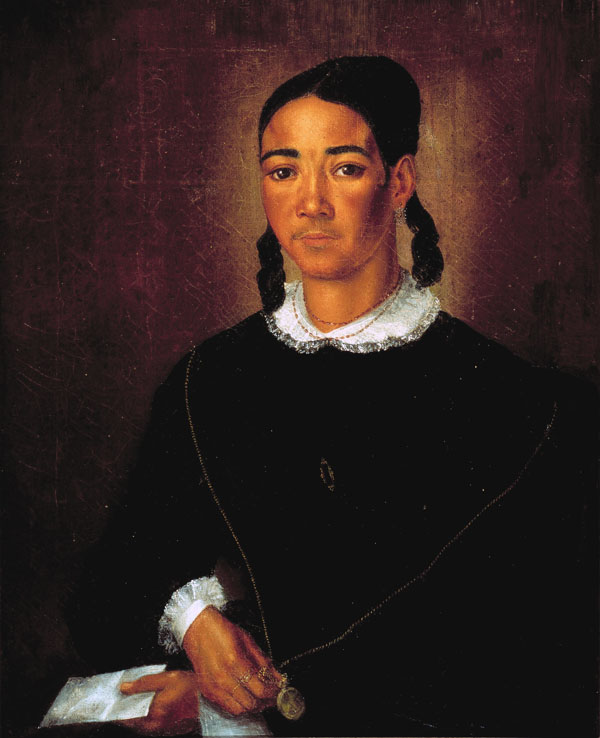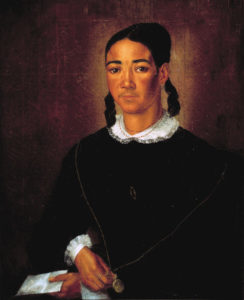Francois Jacques Fleischbein
Though he painted a variety of subjects, German-born painter François Jacques Fleischbein is best known as portraitist who worked in New Orleans between 1834 and 1868.

Courtesy of New Orleans Museum of Art
A painting by Francois Fleischbein titled "Portrait of a Free Woman of Color."
Though he painted a variety of subjects, German-born painter François Jacques Fleischbein is best known for the portraits that he painted in New Orleans between 1834 and 1868. Fleischbein, like many other European artists, ventured to New Orleans to take advantage of the thriving market for portraiture during the mid-nineteenth century. Fleischbein painted in a style is polished, meticulous, and straightforward, influenced by the realism of the German Biedermeir movement. In some ways this microscopic attention to detail anticipated photographic portraiture, a medium he adapted later in his career.
Early Life
Born Franz Joseph Fleischbein in Godramstein, Bavaria, the artist was the son of Henry Fleischbein and Barbara Stumph. (He adopted “François Jacques,” the French translation of his German name, when he moved to New Orleans.) As a young man, Fleischbein appears to have studied art in Munich before entering the École des Beaux Arts in Paris during the early 1820s. It has been suggested that he, like Jean-Joseph Vaudechamp, was a student of Anne-Louis Girodet de Roussy-Trioson. However, Fleischbein’s mature style bears only a slight resemblance to the neoclassicism advocated by Roussy-Trioson. His early sketchbooks demonstrate his mastery of the drawing conventions taught in the École.
Fleischbein married Marie Louise Tetu Paris sometime in the late 1820s or early 1830s. Although the circumstances surrounding his departure from Europe are unclear, Fleischbein’s move to New Orleans in 1833 was no doubt motivated, at least in part, by the promise of a flourishing portrait market. Vaudechamp, the most successful portraitist in the city at the time, was earning several thousand dollars a season, a hefty sum in those days. Fleischbein seems to have known Vaudechamp and may have been encouraged by the older artist to immigrate. Whatever the reason for his relocation, Fleischbein appears to have remained in Louisiana for the rest of his life. Four children were born in Louisiana; two of them, son Ernest and daughter Emma Elizabeth, became painters.
Career in New Orleans
Fleischbein painted a wide array of subjects, including historical and mythological scenes, but focused on portraiture in Louisiana. He painted many portraits of children and men, but his depictions of Creole Louisiana ladies with elaborate—seemingly bizarre—hairstyles set in fantastic landscapes have garnered the most attention. At first glance, these portraits appear mannered and strange—as if painted by a naïve artist. Attenuated figures and other anatomical distortions, an emphasis on pattern, even lighting, and microscopic attention to detail distinguish his works from those of his French colleagues. But it is a mistake to link his style to folk painting.
Fleischbein’s paintings bear many of the hallmarks of the German Biedermeir style, an early nineteenth-century artistic movement emphasizing realism. The somewhat harsh light, stark modeling, and lack of shading recall the work of prominent German artists such as Carl Joseph Begas. Indeed, Fleischbein’s use of mannerisms and distortions represent a sophisticated effort to convey a sense of middle-class comfort and moral values by painting in a straightforward and eminently legible style. According to an advertisement in the Courier on December 9, 1836, sitters could be assured that the “greatest correctness of drawing and painting is guaranteed, as well as the likeness of portraits.”
Commentators have suggested that Fleischbein’s unique style was a result of his failing eyesight. Although his eyes did begin to fail in the 1850s, it is clear that the artist’s style did not change as a result. As his vision began to fail, however, he may have increasingly turned to photography, opening a gallery specializing in ambrotypes and daguerreotypes in Faubourg Marigny in 1858.
Apart from his children Fleischbein had no direct followers, but he did have at least one student. Artist George David Coulon studied painting with him briefly about 1837. Fleischbein’s compositions presage the so-called grand manner painting in the Deep South popular on the eve of the Civil War, characterized by family groups in landscape settings. The portraits of children by artists such as William Henry Baker and fellow German émigré William Rümpler offer compelling comparisons. These artists seem to have borrowed Fleischbein’s visual language of gesture and pose to underscore the relationships among family members. Similarly, their emphasis on landscape conceived both as a pastoral setting and means of economic support can be traced to Fleischbein’s portraits of the 1830s.
Fleischbein died in New Orleans in 1868; his work is not well known outside of Louisiana. The Louisiana State Museum and Historic New Orleans Collection are among the few museums that have significant collections of his paintings. A number also remain in private collections.
